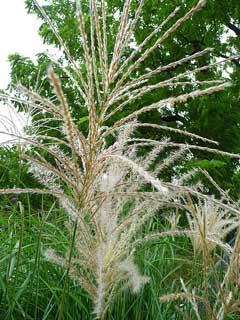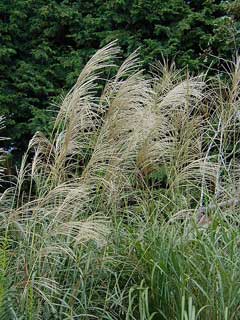 |
|
http://commons.wikimedia.org/wiki/User:4028mdk09 |
 |
| http://commons.wikimedia.org/wiki/User:Miya.m |
Translate this page:
Summary
Bloom Color: Pink, Red. Main Bloom Time: Early fall, Late summer, Late fall, Mid fall. Form: Upright or erect.
Physical Characteristics

 Miscanthus sinensis is a PERENNIAL growing to 4 m (13ft) by 1 m (3ft 3in) at a fast rate.
Miscanthus sinensis is a PERENNIAL growing to 4 m (13ft) by 1 m (3ft 3in) at a fast rate.
See above for USDA hardiness. It is hardy to UK zone 4 and is not frost tender. It is in flower from August to September. The species is hermaphrodite (has both male and female organs) and is pollinated by Wind.
Suitable for: light (sandy), medium (loamy) and heavy (clay) soils and prefers well-drained soil. Suitable pH: mildly acid, neutral and basic (mildly alkaline) soils. It can grow in semi-shade (light woodland) or no shade. It prefers moist soil. The plant can tolerates strong winds but not maritime exposure.
UK Hardiness Map
US Hardiness Map
Synonyms
Plant Habitats
Ground Cover; Cultivated Beds;
Edible Uses
Edible Parts: Stem
Edible Uses:
Immature flowering spike[105, 177]. No further details are given.
References More on Edible Uses
Medicinal Uses
Plants For A Future can not take any responsibility for any adverse effects from the use of plants. Always seek advice from a professional before using a plant medicinally.
Anticoagulant Diuretic Febrifuge
The juice of young stems is used to disperse poisons, dissolve blood clots, dissipate extravasated blood and remove inflammation[218]. The plant is diuretic and refrigerant[147, 218].
References More on Medicinal Uses
The Bookshop: Edible Plant Books
Our Latest books on Perennial Plants For Food Forests and Permaculture Gardens in paperback or digital formats.

Edible Tropical Plants
Food Forest Plants for Hotter Conditions: 250+ Plants For Tropical Food Forests & Permaculture Gardens.
More

Edible Temperate Plants
Plants for Your Food Forest: 500 Plants for Temperate Food Forests & Permaculture Gardens.
More

More Books
PFAF have eight books available in paperback and digital formats. Browse the shop for more information.
Shop Now
Other Uses
Biomass
Being increasingly grown as a source of biomass, trials are currently (1992) taking place on its potential in Britain[K]. Plants form impenetrably dense clumps and when planted close together in drifts make an excellent ground cover[200].
Special Uses
Carbon Farming Ground cover
References More on Other Uses
Cultivation details
Industrial Crop: Biomass Management: Hay Minor Global Crop
Landscape Uses:Border, Container, Foundation, Ground cover, Rock garden, Seashore, Specimen. Prefers a deep fertile loamy soil that does not dry out in summer[200] but succeeds in any ordinary soil that is not too dry[1, 162], in sun or light shade[200]. Fully dormant plants are hardy to about -20°c[187], though the young growth in spring can be damaged by late frosts. Often grown as an ornamental plant, there are many named varieties[162]. Many forms do not get enough summer heat to flower freely when they are grown in Britain, 'Silberfeder' (syn 'Silver Feather') is the most free-flowering in cooler climates[187]. Plants can be grown as a focal point in lawns, they also succeed in quite coarse grass[233]. The leaves have saw-toothed edges that can cut the unwary gardener, it is best to wear gloves when working with the plant[200]. Plants seem to be immune to the predations of rabbits[233]. Special Features:
Attracts birds, Attractive foliage, Not North American native, Suitable for cut flowers, Suitable for dried flowers, Attractive flowers or blooms.
Carbon Farming
-
Industrial Crop: Biomass
Three broad categories: bamboos, resprouting woody plants, and giant grasses. uses include: protein, materials (paper, building materials, fibers, biochar etc.), chemicals (biobased chemicals), energy - biofuels
-
Management: Hay
Cut to the ground and harvested annually. Non-destructive management systems maintaining the soil organic carbon.
-
Minor Global Crop
These crops are already grown or traded around the world, but on a smaller scale than the global perennial staple and industrial crops, The annual value of a minor global crop is under $1 billion US. Examples include shea, carob, Brazil nuts and fibers such as ramie and sisal.
References Carbon Farming Information and Carbon Sequestration Information
Temperature Converter
Type a value in the Celsius field to convert the value to Fahrenheit:
Fahrenheit:
The PFAF Bookshop
Plants For A Future have a number of books available in paperback and digital form. Book titles include Edible Plants, Edible Perennials, Edible Trees,Edible Shrubs, Woodland Gardening, and Temperate Food Forest Plants. Our new book is Food Forest Plants For Hotter Conditions (Tropical and Sub-Tropical).
Shop Now
Plant Propagation
Seed - surface sow in spring in a greenhouse and keep moist. Germination should take place within a couple of weeks. When they are large enough to handle, prick the seedlings out into individual pots and grow them on in the greenhouse for their first winter. Plant them out into their permanent positions in late spring or early summer, after the last expected frosts. Division in spring or early autumn[200]. Very easy, large divisions can be planted out direct into their permanent positions. We have found that it is better to pot up the smaller divisions and grow them on in light shade in a cold frame until they are well established before planting them out in late spring or early summer.
Other Names
If available other names are mentioned here
Native Range
TEMPERATE ASIA: Russian Federation (Kurile Islands (south), Primorye (south), Sakhalin (south)), China (Anhui Sheng, Fujian Sheng, Gansu Sheng, Guangdong Sheng, Guangxi Zhuangzu Zizhiqu, Guizhou Sheng, Hainan Sheng, Hebei Sheng, Heilongjiang Sheng, Henan Sheng, Hubei Sheng, Hunan Sheng, Jiangsu Sheng, Jiangxi Sheng, Jilin Sheng, Shaanxi Sheng, Shandong Sheng, Sichuan Sheng, Yunnan Sheng, Zhejiang Sheng), Hong Kong, Korea, Japan (Hokkaidô, Honshu, Kyushu, Shikoku), Taiwan TROPICAL ASIA: Indonesia (Sulawesi), Philippines
Weed Potential
Right plant wrong place. We are currently updating this section.
Please note that a plant may be invasive in one area but may not in your area so it's worth checking.
Conservation Status
IUCN Red List of Threatened Plants Status :

Growth: S = slow M = medium F = fast. Soil: L = light (sandy) M = medium H = heavy (clay). pH: A = acid N = neutral B = basic (alkaline). Shade: F = full shade S = semi-shade N = no shade. Moisture: D = dry M = Moist We = wet Wa = water.
Now available:
Food Forest Plants for Mediterranean Conditions
350+ Perennial Plants For Mediterranean and Drier Food Forests and Permaculture Gardens.
[Paperback and eBook]
This is the third in Plants For A Future's series of plant guides for food forests tailored to
specific climate zones. Following volumes on temperate and tropical ecosystems, this book focuses
on species suited to Mediterranean conditions—regions with hot, dry summers and cool, wet winters,
often facing the added challenge of climate change.
Read More
Expert comment
Author
Andersson.
Botanical References
58200
Links / References
For a list of references used on this page please go here
Readers comment
| Add a comment |
|
If you have important information about this plant that may help other users please add a comment or link below. Only comments or links that are felt to be directly relevant to a plant will be included. If you think a comment/link or information contained on this page is inaccurate or misleading we would welcome your feedback at [email protected]. If you have questions about a plant please use the Forum on this website as we do not have the resources to answer questions ourselves.
* Please note: the comments by website users are not necessarily those held by PFAF and may give misleading or inaccurate information.
To leave a comment please Register or login here All comments need to be approved so will not appear immediately.
|
Subject : Miscanthus sinensis
|
|
|
|